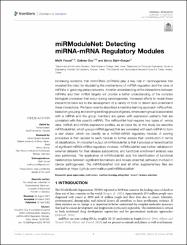| dc.contributor.author | Yousef, Malik | |
| dc.contributor.author | Goy, Gokhan | |
| dc.contributor.author | Bakır Güngör, Burcu | |
| dc.date.accessioned | 2022-06-30T13:16:28Z | |
| dc.date.available | 2022-06-30T13:16:28Z | |
| dc.date.issued | 2022 | en_US |
| dc.identifier.issn | 1664-8021 | |
| dc.identifier.other | WOS:000792606300001 | |
| dc.identifier.uri | https://doi.org/10.3389/fgene.2022.767455 | |
| dc.identifier.uri | https://hdl.handle.net/20.500.12573/1302 | |
| dc.description.abstract | Increasing evidence that microRNAs (miRNAs) play a key role in carcinogenesis has revealed the need for elucidating the mechanisms of miRNA regulation and the roles of miRNAs in gene-regulatory networks. A better understanding of the interactions between miRNAs and their mRNA targets will provide a better understanding of the complex biological processes that occur during carcinogenesis. Increased efforts to reveal these interactions have led to the development of a variety of tools to detect and understand these interactions. We have recently described a machine learning approach miRcorrNet, based on grouping and scoring (ranking) groups of genes, where each group is associated with a miRNA and the group members are genes with expression patterns that are correlated with this specific miRNA. The miRcorrNet tool requires two types of -omics data, miRNA and mRNA expression profiles, as an input file. In this study we describe miRModuleNet, which groups mRNA (genes) that are correlated with each miRNA to form a star shape, which we identify as a miRNA-mRNA regulatory module. A scoring procedure is then applied to each module to further assess their contribution in terms of classification. An important output of miRModuleNet is that it provides a hierarchical list of significant miRNA-mRNA regulatory modules. miRModuleNet was further validated on external datasets for their disease associations, and functional enrichment analysis was also performed. The application of miRModuleNet aids the identification of functional relationships between significant biomarkers and reveals essential pathways involved in cancer pathogenesis. | en_US |
| dc.language.iso | eng | en_US |
| dc.publisher | RONTIERS MEDIA SAAVENUE DU TRIBUNAL FEDERAL 34, LAUSANNE CH-1015, SWITZERLAND | en_US |
| dc.relation.isversionof | 10.3389/fgene.2022.767455 | en_US |
| dc.rights | info:eu-repo/semantics/openAccess | en_US |
| dc.subject | gene expression | en_US |
| dc.subject | multi omics | en_US |
| dc.subject | machine learning | en_US |
| dc.subject | integrative "omics" | en_US |
| dc.subject | feature selection | en_US |
| dc.title | miRModuleNet: Detecting miRNA-mRNA Regulatory Modules | en_US |
| dc.type | article | en_US |
| dc.contributor.department | AGÜ, Mühendislik Fakültesi, Bilgisayar Mühendisliği Bölümü | en_US |
| dc.contributor.institutionauthor | Bakır Güngör, Burcu | |
| dc.contributor.institutionauthor | Göy, Gökhan | |
| dc.identifier.volume | 13 | en_US |
| dc.identifier.startpage | 1 | en_US |
| dc.identifier.endpage | 11 | en_US |
| dc.relation.journal | FRONTIERS IN GENETICS | en_US |
| dc.relation.publicationcategory | Makale - Uluslararası Hakemli Dergi - Kurum Öğretim Elemanı | en_US |


















